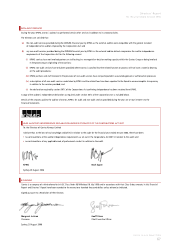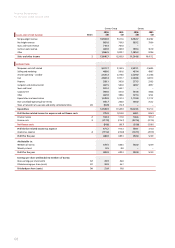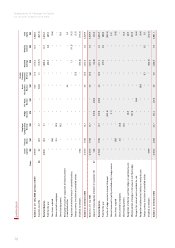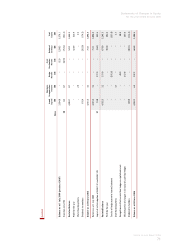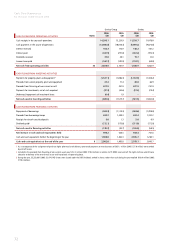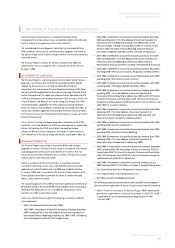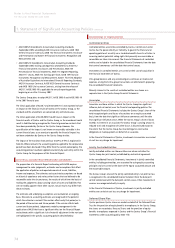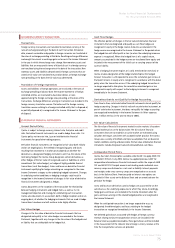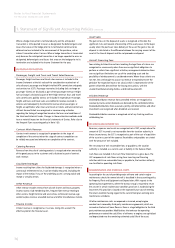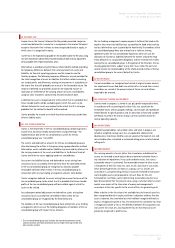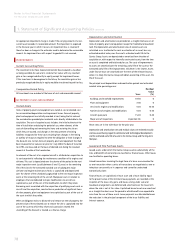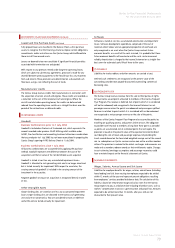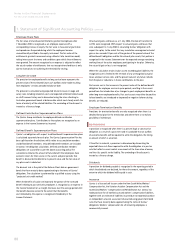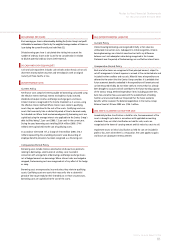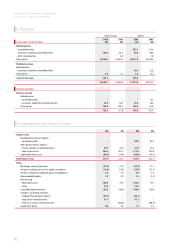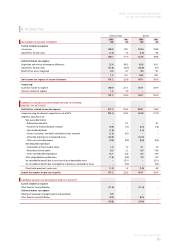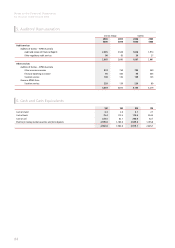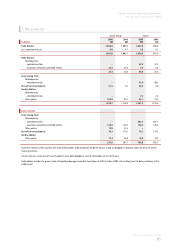Qantas 2006 Annual Report Download - page 77
Download and view the complete annual report
Please find page 77 of the 2006 Qantas annual report below. You can navigate through the pages in the report by either clicking on the pages listed below, or by using the keyword search tool below to find specific information within the annual report.
75
Qantas Annual Report 2006
Notes to the Financial Statements
for the year ended 30 June 2006
(E) FOREIGN CURRENCY TRANSACTIONS
Transactions
Foreign currency transactions are translated to Australian currency at the
rates of exchange prevailing at the date of each transaction. At balance
date, amounts receivable and payable in foreign currencies are translated at
the rates of exchange prevailing at that date. Resulting exchange differences
are brought to account as exchange gains or losses in the Income Statement
in the year in which the exchange rates change. Non-monetary assets and
liabilities that are measured in terms of historical cost in a foreign currency
are translated using the exchange rate at the date of the transaction. Non-
monetary assets and liabilities denominated in foreign currencies that are
stated at fair value are translated to Australian dollars at foreign exchange
rates prevailing at the dates the fair value was determined.
Translation of Foreign Operations
Assets and liabilities of foreign operations are translated at the rates of
exchange prevailing at balance date. The Income Statements of foreign
controlled entities are translated to Australian dollars at rates
approximating the foreign exchange rates prevailing at the dates of the
transactions. Exchange differences arising on translation are recorded in the
foreign currency translation reserve. The balance of the foreign currency
translation reserve relating to a foreign controlled entity that is disposed of,
or partially disposed of, is recognised in the Income Statement in the year
of disposal.
(F) DERIVATIVE FINANCIAL INSTRUMENTS
Current Period Policy
Qantas is subject to foreign currency, interest rate, fuel price and credit
risks. Derivative financial instruments are used to hedge these risks. It is
Qantas policy not to enter into, issue or hold derivative financial
instruments for speculative trading purposes.
Derivative financial instruments are recognised at fair value both initially
and on an ongoing basis. The method of recognising gains and losses
resulting from movements in market prices depends on whether the
derivative is a designated hedging instrument, and if so, the nature of the
item being hedged. The Qantas Group designates certain derivatives as
either hedges of the fair value of recognised assets or liabilities or a firm
commitment (fair value hedges); or hedges of highly probable forecast
transactions (cash flow hedges). Gains and losses on derivative financial
instruments qualifying for hedge accounting are recognised in the same
Income Statement category as the underlying hedged instrument. Changes
in underlying market conditions or hedging strategies could result in
recognition in the Income Statement of changes in fair value of derivative
financial instruments designated as hedges.
Qantas documents at the inception of the transaction the relationship
between hedging instruments and hedged items, as well as its risk
management objective and strategy for undertaking each transaction.
Qantas also documents its assessment, both at hedge inception and on an
ongoing basis, of whether the hedging instruments that are used in hedge
transactions have been and will continue to be highly effective.
Fair Value Hedges
Changes in the fair value of derivative financial instruments that are
designated and qualify as fair value hedges are recorded in the Income
Statement, together with any changes in the fair value of the hedged asset
or liability that are attributable to the hedged risk.
Cash Flow Hedges
The effective portion of changes in the fair value of derivative financial
instruments that are designated and qualify as cash flow hedges are
recognised in equity in the hedge reserve. Amounts accumulated in the
hedge reserve are recognised in the Income Statement in the periods when
the hedged item will affect profit or loss (ie when the underlying income or
expense is recognised). Where the hedged item is of a capital nature,
amounts accumulated in the hedge reserve are transferred from equity and
included in the measurement of the initial cost or carrying amount of the
asset or liability.
When a hedging instrument expires or is sold, terminated or exercised, or
Qantas revokes designation of the hedge relationship but the hedged
forecast transaction is still expected to occur, the cumulative gain or loss at
that point remains in equity and is recognised in accordance with the above
policy when the transaction occurs. If the underlying hedged transaction is
no longer expected to take place, the cumulative unrealised gain or loss
recognised in equity with respect to the hedging instrument is recognised
immediately in the Income Statement.
Derivatives that do not Qualify for Hedge Accounting
From time to time, certain derivative financial instruments do not qualify for
hedge accounting. Changes in the fair value of any derivative instrument, or
part of a derivative instrument, that does not qualify for hedge accounting
are recognised immediately in the Income Statement in Other expenses
($44.1 million net loss in the year to 30 June 2006).
Fair Value Calculations
The fair value of financial instruments traded in active markets is based on
quoted market prices at the balance date. The fair value of financial
instruments that are not traded in an active market are estimated using
valuation techniques consistent with accepted market practice. The Qantas
Group uses a variety of methods and input assumptions that are based on
market conditions existing at balance date. The fair value of derivative fi nancial
instruments includes the present value of estimated future cash fl ows.
Comparative Period Policy
Qantas has taken the exemption available under AASB 1 to apply AASB 132
and AASB 139 from 1 July 2005. Qantas has applied previous GAAP for
comparative information on financial instruments within the scope of AASB
132 and AASB 139. Principal amounts outstanding under individual cross-
currency swaps are disclosed as a net asset or liability. Interest payments
and receipts under cross-currency swaps are recognised on an accruals
basis in the Balance Sheet. Premiums paid on interest rate options are
included in Other assets on the Balance Sheet and are amortised over the
period of the hedge.
Gains and losses on derivatives used as hedges are accounted for on the
same basis as the underlying exposures to which they relate. Accordingly,
hedge gains and losses are included in the Income Statement when the
gains and losses arising on the related hedged position are recognised in
the Income Statement.
When the anticipated transaction is no longer expected to occur as
designated, the deferred gains and losses relating to the hedged
transaction are recognised immediately in the Income Statement.
Net deferred gains/losses associated with hedges of foreign currency
revenue relating to future transportation services are included in the
Balance Sheet as payables/receivables. These gains/losses will be included
in the measurement of the relevant future foreign currency revenue at the
time the transportation services are provided.




